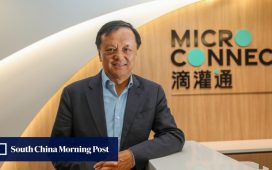Market decline and OPPO’s resurgence
The smartphone market grew rapidly from 2009 to 2017, with annual sales volume jumping from 172 million to 1.5 billion units, according to Statista data. Sales then plateaued and steadily dropped to about 1.4 billion units in 2022.
Said Mr Zhou: “People used to upgrade their phones every one to two years. Now, we find that people are using their phones for more than three years before replacing them. There has been no new innovation to spur upgrades in normal smartphones.”
However, foldable phones have been quietly gaining market share amid the overall market’s decline.
Research firm IDC forecasts that global shipments of foldable phones (including flip and fold form factors) will reach 21.4 million units in 2023, a more than 50 per cent increase year-over-year, while the overall smartphone market is expected to decline by about 1 per cent.
Ms Nabila Popal, a research director with IDC, said: “Foldable devices currently bring that ‘wow factor’ and I believe they will continue to grab more headlines and outperform non-foldable phones over the next five years.”
The risky but prescient bet on foldables has also propelled OPPO into the rarefied premium price band for smartphones.
Before 2021, OPPO had no presence in the price band above S$1,700.
Today, the OPPO Find N3 is going for a recommended price of S$2,399 and is now the 2nd best-selling foldable phone brand in Singapore.
The challenge of making foldables
Success has not come easy for OPPO as foldables are deviously difficult to make.
To achieve the “wow factor” for consumers, OPPO worked relentlessly on the well-known issues of the screen crease, the weight and thickness of foldable phones.
From 2018 to 2021, OPPO iterated six generations of folding prototypes, accumulating 125 patents while experimenting with many mechanisms and space-age materials.
In December 2021, their first foldable Oppo Find N was launched in China starting at 7,699 yuan (S$1,440), making it the cheapest foldable model at the time.
Despite its success of shipment ranking top immediately in the foldable phones category, the first generation of the Find N project was unprofitable due to the high costs of the new screens and phone molds.
Nevertheless, the breakthrough proved Mr Zhou’s original vision to be right and demonstrated OPPO’s ability to excel in the high-end market.
With their thinner and lighter 3rd generation, OPPO has hit its stride, with the OPPO Find N3 selling five times the volume of their most recent flagship smartphone – the non-foldable OPPO Find X5.
Moreover, Singapore has become the fastest growing market in the world for the Find N3.
Beyond the big screen
The OPPO Find N3 has enthralled high-end phone users, not just with its massive 7.8-inch unfolded display and 5.8mm thickness, but also its bendable form factor that lets users take pro-level photos in new ways.






